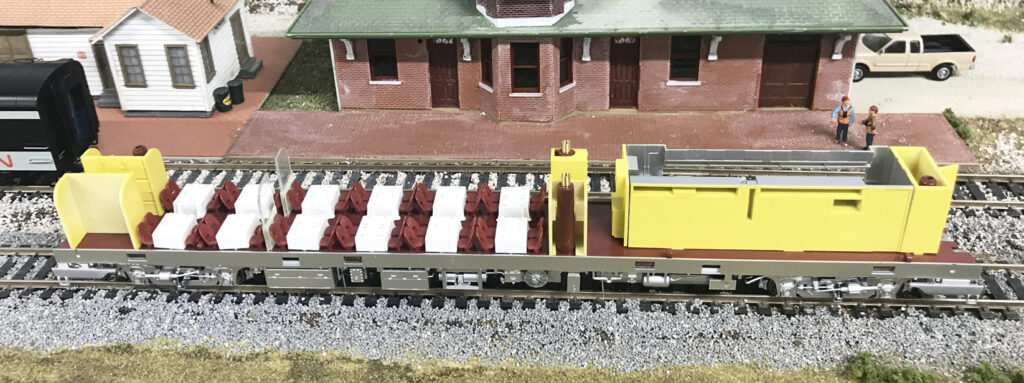All about the community of model railroading and rail enthusiasm
By TIM BLACKWELL/Cowcatcher Magazine
On a cool evening, a businessman and woman enjoy baked fresh fish, garden vegetables and potatoes over an early dinner to the gentle sway of the Southern Pacific’s Pacific Limited. The server waits to clear their plates and bring a cold dish of ice cream and wafers for dessert. But first, the lady dressed in red asks for more water.
The server swiftly arrives and refreshes drinks, using the water pitcher on the table.
The scene was common on Pullman-Standard lightweight dining cars well into the 1960s. Dining on train trips had an eclectic flare, and passengers could expect a good meal on a fully set table right down to the butter knife. Friendly, prompt service was the order of the day.
For the past decade, Rapido Trains has stirred memories of the glory of passenger railroading with its HO-scale models. But its just-released Super Continental Line Pullman-Standard Lightweight Dining Car takes the cake.
Not since 2014 has Rapido offered a Super Continental Line car, and the last six years have been worth the wait. The lightweight car, a reproduction of rolling eateries that roamed the nation’s rail network every day, captures the essence of passenger rail.
In June we received samples of the Southern Pacific and Canadian National “Wet Noodle” models, two of the 19 paint schemes that Rapido released earlier this year. Among the other roads offered are Great Northern, Chicago and North Western, Canadian National, Illinois Central, VIA and Northern Pacific.

Rapido introduced the ready-to-run Super Continental Line in 2005 with its Lightweight Coach and Duplex Sleeper. Since then, the company has improved passenger car designs up to the New Haven stainless coaches and Budd Mid-Train Domes.
The Dining Car is no exception and got our attention right out of the box.
The finely detailed silver paint with red striping and SP Daylight logo was a sight to behold. So was the black and silver scheme with its crisply painted red CN “Wet Noodle.”
Then we saw the complex network of equipment and piping on the underside and the detailed interior.
The wealth of generators, brake cylinders, battery boxes, pumps, air tanks, hoses and other equipment – all consistent with operating a dining car – appear underneath in pleasing precision.
Inside, white linens and place settings adorn tables. Table cloths fan out onto the floor, and plates and silverware are painted; add-on water pitchers can be placed on each table.
Depending on the road, models come with 32-, 40- and 48-seat dining rooms. The SP sent for review is arranged in a 48-seat configuration; the CN has 32 seats and a four-table lounge area.

All kitchen equipment is appropriately detailed.
The amount of detail inspired removing the car body to put a couple of diners and a water pitcher at one table. This took a little patience at first.
While Rapido includes four pages of instructions (two each in French and English), removing the car body is not mentioned. After prying the sides, it was apparent the car would not come apart.
A quick email to our contact at Rapido revealed that the car body and chassis are connected by screws that hold the body-mount couplers in place. Once the couplers were removed, the car body lifted off easily (Rapido said it plans to post a video on its website about how to remove the shell).
With the car body off, a man and a woman from Walthers’ SceneMaster sitting people set were placed at a table. Sadly, their legs had to be removed because the table cloth isn’t real.
A water pitcher, which comes separate along with marker lights, was glued to the table using plastic cement.

For added realism, the interior is evenly lighted. The car has metal wheels and picks up power, which provides current to an LED light that works on DC and DCC track. Lights can be turned on and off by waving a magnetic wand (enclosed with each model) over a hidden switch on the center of the roof.
The lighting system is an improvement from previous models powered by batteries. A capacitor provides flicker-free lighting over dirty track.
Lighting kits and trucks can be purchased separately to upgrade previous Rapido models.
Cars are equipped with 41-N-11 inside-swing hanger trucks suitable for sweeping curves. The trucks can be altered for operation on tight or medium curves (see manufacturer recommendations).
Rapido installed upgraded body-mount medium-shank couplers that are 1 mm longer than installed on previous models. The car is designed to run on 28-inch radius curves and higher, and the slightly longer shank improves tracking. Long-shank couplers are included for curves 18-inch radius and higher. Rapido recommends running the cars on 28-inch radius curves and higher.
When placed in service on the Cowcatcher’s North Tarrant & Pacific, coupling seemed stiff and erratic. Until “exercising” the coupler springs a bit, the cars wouldn’t couple with each other or other rolling stock. The couplers worked more reliably after some minor adjustments.
Above the couplers, each end of the car has a working diaphragm and realistic etched metal gates. The diaphragms are spring loaded and adjust as the car moves around curves to maintain smooth tracking.
Overall, the car runs smoothly and feels solid on the rails, which enhances operations from mainline duty to yard movements. The level of detail begs careful handling − fat fingers can easily damage the Barco steam line connectors and other parts of the underbody − but the realism is worth the investment in care and money ($119.95 U.S.; $129.95 Canada).
Rapido stands by the quality of the car with its limited five-year warranty. This Super Continental Line offering deserves a toast.
Visit our product review page here.